Despite not needing yet another rifle, I still browsed the rifle shelves at my local gunshop. I’m not sure why I allowed myself to do this, because it often ends in disaster (for my wallet). Well, this occasion was no different. I really wasn’t in the market for anything, but sure enough, a rifle caught my eye—a Mark II FV-SR.
The Kryptek camo pattern caught my eye briefly, and then my eye went to the barrel, which was fluted and of a “bronze” Cerakote color. Oh my, what have we here! I’m a sucker for heavy, fluted barrels, especially those wearing a cool color, which this one certainly was.
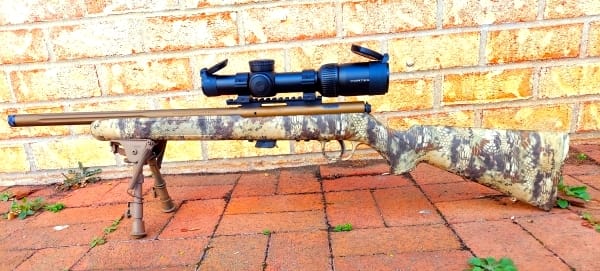
Naturally, I snatched it off the shelf to take a closer look. It was my first introduction to the Savage Mark II FV-SR .22 caliber rifle. I’d long known about Savage’s reputation for accuracy, so just having the Savage name on the barrel was a good endorsement.
Immediately, I noted that the composite stock was smallish and would fit a youth extremely well. Now I’m no youth (or “Yute”, as Vinny Gambini would have pronounced it), but I do not have long arms, which makes me appreciate Yute-sized firearms. And this little rifle struck me as “Yute-sized.” It was bolt action and also had a Picatinny rail mounted on the receiver for easy scope mounting. So far, things were looking good.
Ah, and it was in .22 Long Rifle! I cut my teeth on the .22 back when I was five and Dad had me touch off my first round from his bolt action Marlin .22. Ever since then, I’ve had a soft spot for the little .22LR. The fact that this rifle was in one of my favorite calibers put the cherry on top of this sundae.
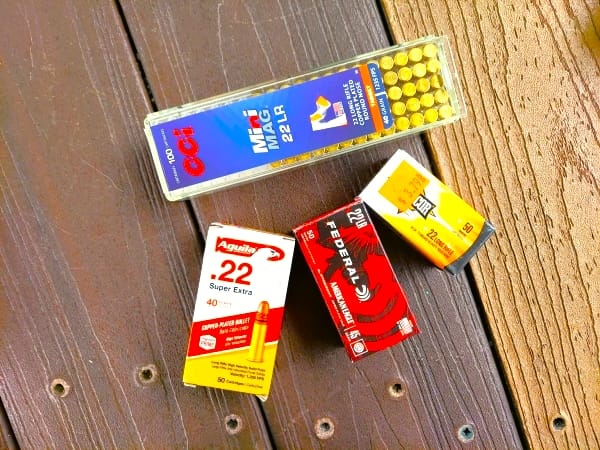
A few people of my acquaintance won’t consider the .22 Long Rifle with any seriousness. One friend won’t even consider buying one, despite my ravings about all of the .22’s advantages. But since I’m thinking of it right now, let’s take a look at those advantages.
Advantages of the .22 Long Rifle Cartridge
Inexpensive
Even as this is written, in the midst of the worst ammo scare/shortage/hoarding in history, I can pick up a 100-round box of CCI .22LR at my local shop for $11.95. That’s not a steal until we compare it to, say, a box of .45 ACP. When we look at what every other caliber is selling for, things come into focus quickly.
Because it’s inexpensive, we can practice with the .22 a whole lot more—and practice & training are where it’s at.
Quiet
Simply put, it’s just not as loud as other calibers. It’s easier on the hearing. And sometimes, we might not want to attract a lot of attention, so it allows us to remain more discreet than most other calibers. Especially with subsonic ammunition.
More Variety
There are many configurations that a bolt action .22 can fire, from CB Caps (which are projectiles with a very light charge), the .22 Short (shorter than a Long Rifle, not as powerful, but quieter), and others. Subsonic ammunition is also available, as is bird and snake shot.
Light & Compact
Compared to other ammo, the .22LR is compact and lighter. A 500-round brick weighs but a few pounds and is about the size of two boxes of .308 or similarly sized ammunition. You can throw 500 rounds of .22LR in a day pack and hit the woods with plenty of room left over in that pack. And 500 rounds will last a little while.
Extremely low recoil
This aspect is perfect for teaching new shooters because the gun won’t beat the hell out of them and there’s not much muzzle blast to scare them. For experienced shooters, the low recoil permits faster follow-up shots. Everyone wins in this department.
Widely Available
Nearly every place that sells ammunition is going to have .22 for sale.
While most people were going bananas snatching up every large caliber that they could during the ammo scare, I was quite content to snap up .22LR when I couldn’t get the other stuff. I have far more .22 than any of my other calibers, which means I will be able to keep shooting for a very long time if ammo ever dries up completely.
Back to the Rifle
Among the reasons I wanted this rifle was that I have a substantial stash of .22LR ammo, so I would be able to shoot this rifle without feeling the crunch in my wallet. Needless to say, it came home with me.
Since I will be adding a scope, I like the idea that it can be a light precision rifle that could potentially get game or even protect the homestead if necessary. And let’s face it, the potential for the world to deteriorate overnight is rising by the moment. One never knows what tomorrow might bring.
In that vein, it would be very difficult to detect a sniper’s position if this rifle were fired from inside a building, as the building would contain much of the very modest muzzle blast. The building would somewhat serve as a suppressor, containing the sound. Using subsonic ammunition would, of course, carry this one step further, as there would be no sonic crack to alert people that bullets were incoming. Normally, a sniper stays well back from windows and other openings in buildings, so the further back into the building the shooter is, the more the blast is contained.
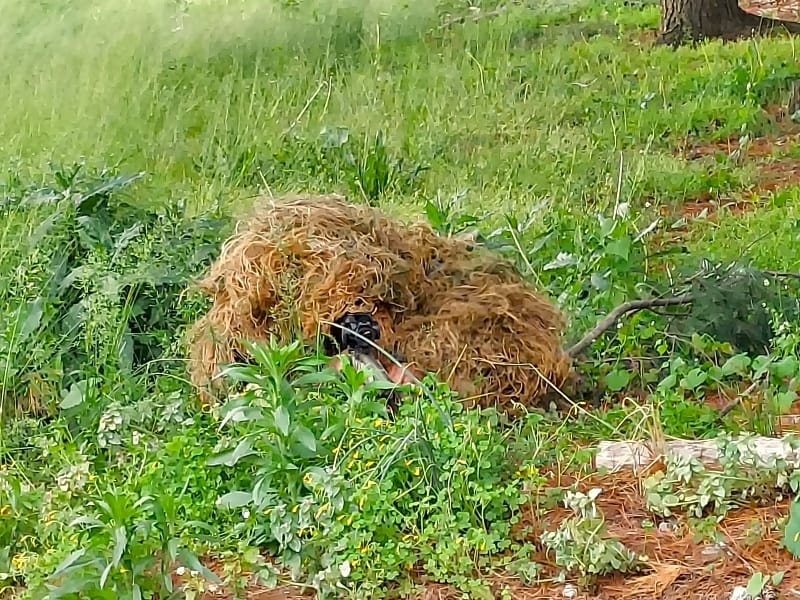
A friend from abroad tells me that .22 Long Rifle caliber weapons were used by snipers in Chechnya for many reasons listed here: chiefly, it’s quiet and the user can carry a lot of ammo.

Mark II FV-SR Specs
The barrel is 16.5 inches of fluted Carbon Steel with a 1:16 twist rate with a “bronze” Cerakote finish that looks very cool and low-key. It’s 32.25 inches in length and weighs 5.5 pounds. As already mentioned, the stock is synthetic. It is fed by a box magazine; a 5-round magazine is included, but 10-round magazines are available as extras, and I did purchase two 10-round magazines for my rifle.
The muzzle is threaded in the event the user wants to add a suppressor, and comes with a threaded muzzle cap that is black in color. Flash suppressors and other muzzle devises can also be screwed onto these threads. Not that it needs such a device, but I may look into this just for the cool factor.

Savage has installed their Accu-Trigger on the Mark II FV-SR and it is a seriously nice trigger. I mean, it’s head and shoulders above many other triggers on far more expensive rifles that I’ve used. It’s light and crisp, with a predictable break. This trigger will facilitate excellent accuracy. I is adjustable. However, I have no urge to adjust mine as it is excellent as it came from the factory.
The Vortex Strike Eagle Scope
Vortex Optics was kind enough to supply a scope for this rifle. Their newly released Strike Eagle 1-8×24 utilizes an FFP (First Focal Plane) reticle. This is an advantage because the reticle will scale with magnification, and the subtensions that are used for ranging, holdovers, and wind corrections will be accurate at all magnifications. With a second focal plane, they are visually consistent in size, but typically only accurate on the highest magnification.
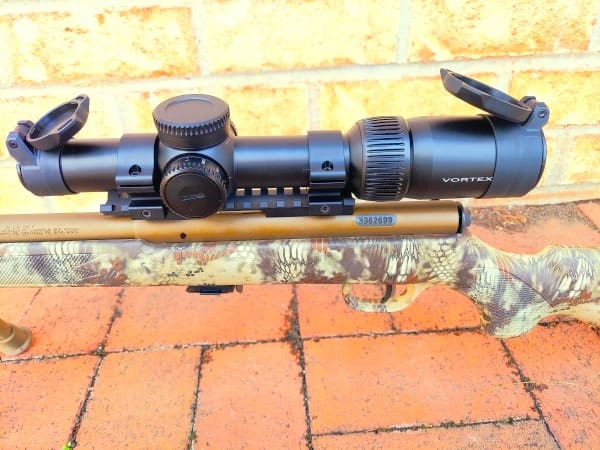
The Strike Eagle’s tube size is 30mm, weighs 23.9 ounces, and is 10.4 inches long. There are nine daylight and two night-vision-compatible reticle illumination settings with a battery life of 47 hours with the illumination set at level 5. The illumination is powered by a CR2032 battery. However, the scope will work without the reticle illuminated because the reticle is etched in the glass.
The reticle performs like a red dot at 1x and there are holdovers out to 600 yards. It also includes a ranging feature that allows the shooter to make quick decisions in the reticle. The adjustment turrets have caps so once the shooter has a zero, they can be capped securely. Also, a throw lever that fits onto the power ring so that the powers can be quickly and easily changed. Obviously, the .22LR is not going to be shot at 600 yards, but for those mounting this scope on an AR-15 or other rifle, it is a very real possibility.
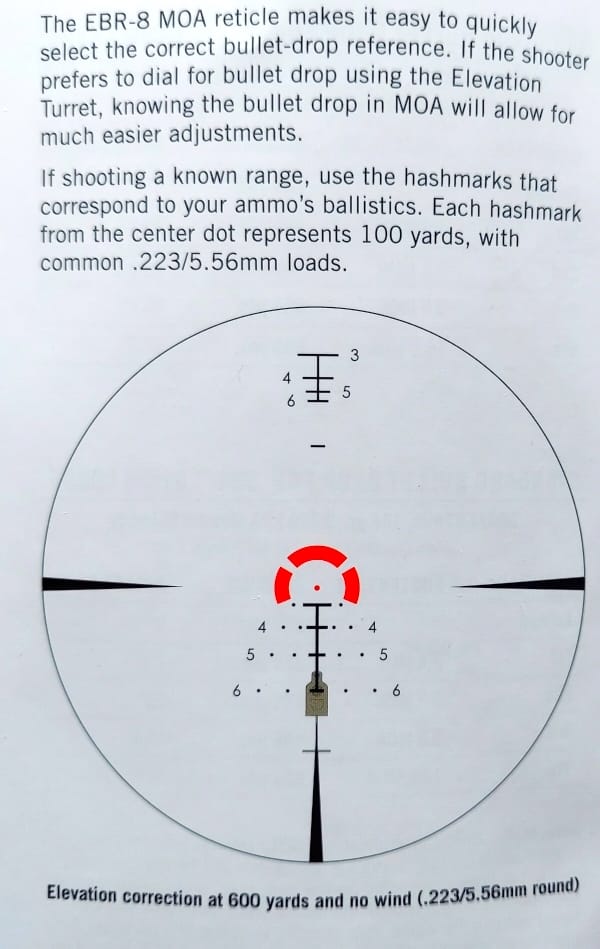
Adjustments for the Strike Eagle are ¼ Minute at 100 yards. The total elevation and windage adjustments are 145 Minute Of Angle (MOA), so there is considerable room for adjustments on this optic. The adjustment turrets have covers that screw off and on to protect the turrets. Parallax is set for 125 yards.
The scope appears to be geared chiefly for AR-15-type weapons but is likely to work with most rifles. It’s fairly compact and doesn’t weigh a lot, so it won’t get in the way as some larger scopes would. The magnification range is generous, and since it goes up to 8x, it gives a nice amount of magnification allowing distant targets to be engaged while still allowing a wide field of view.
On the other hand, set at 1X, the scope would serve perfectly for CQB type ranges, especially with the reticle lit up; it would be like using a red dot scope. That’s where the major versatility of this optic comes into play. From room distance out to several hundred yards, it will fill the bill for whatever you need.
The reticle consists mainly of an upside-down horseshoe with a small dot in the center as the aiming point. Overall, it works very well, with that small dot allowing precision, and the horse shoe’s semi-circle helps if the user is acquiring targets quickly. Altogether, it is a great combination to address the shooter’s needs.
There is a range finder that helps in ranging targets out to 600 yards, and there are holdovers for various ranges. As well, there are hold-offs for windage. All in all, the reticle has lots of options for the shooter.
The Mark II FV-SR Stock
I’ve heard criticisms against the “plastic” stock that this rifle is equipped with. I simply cannot wrap my head around why these criticisms exist. It is a .22, so there is not going to be a tremendous amount of abuse unleashed by the caliber upon the stock (or any other component of the rifle). What’s more, the low price point dictates that we’re not going to see a designer stock attached to this rifle.
Despite the criticisms, the stock feels, at least to me, to be utterly and completely adequate for the given task. What’s more, it’s attractive! It free floats the barrel, which I’m sure is a factor in this rifle’s considerable accuracy.
Bolt Handle
Another nice point worth mentioning is the oversized bolt handle that Savage included on the rifle. It makes cycling the bolt a real pleasure. I find myself wishing that all my bolt action rifles had this luxury included.
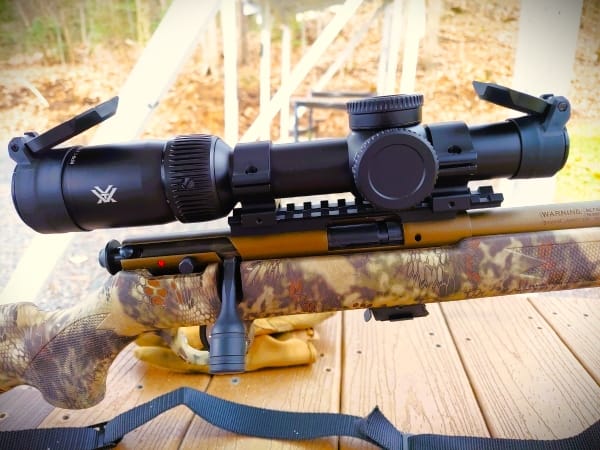
Druthers
My only slight criticism is about the magazine retention/release lever because it is made from a very thin piece of metal. I’d just feel a little more comfortable if the piece were more solid and robust. That said, I had no trouble with it. It didn’t even come close to malfunctioning, so this does not appear to be an actual issue. Rather, it’s my personal preference.
Although it added additional weight, I installed a bipod that adjusts from six to nine inches on the forend. That came in handy when shooting from the bench for sight-in.
At The Range
Because of the light weight and short overall length, the little rifle handles like a dream! It’s a serious pleasure to handle.
As expected, the FV-SR performed nicely. I began zeroing the scope at 25 yards. It was a matter of a few rounds before I had it dialed in perfectly. I did notice that at the 25-yard mark, the target was a bit blurry when set on 8 power, while targets past 25 yards were crystal clear. Either the scope is not designed for that close range when set on the highest magnification, or my eyesight is just a bit off. At any rate, I got it dialed in quickly and accurately.
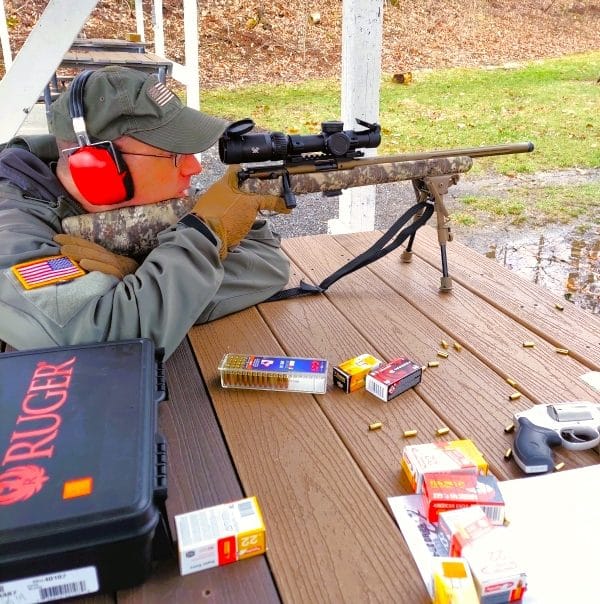
Using a variety of ammunition, I shot at 25 and 50 yards. At 25 yards, the rifle easily turned in groups that were just under an inch. At 50 yards, groups were about the same size. I had no match-grade ammunition on hand, so what I was using was a mixture of CCI, Federal subsonic, Aquila, and Armscor. Everything performed fairly well!
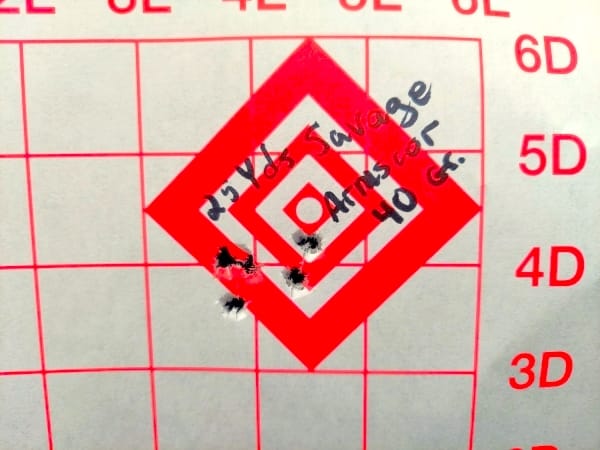
When my daughter shot the rifle, she was incredulous at how little recoil and noise there was, especially with the subsonic ammo. To be fair, she had just finished firing her AR-15, so the comparison was even more marked, and I had to chuckle at how she marveled at the .22’s characteristics. She’d just discovered some of the .22’s advantages, and I told her so (although she had already put that together).
For that particular range session, it was drizzling and there was a 25-mile-per-hour wind in my face, with temperatures in the 40’s. Needless to say, these weren’t conditions that were conducive for accurate shooting.

I’m hoping to lay hands upon some match-grade ammunition to see what this rifle can really do in the future. The fact that it did so well with standard ammunition means it can only get better with Match ammo. And there will definitely be many more outings with this rifle in the future because it just jumped to being one of my favorite rifles in my inventory. To be honest, it was just plain fun to shoot and it brought smiles to our faces (despite the miserable weather)!
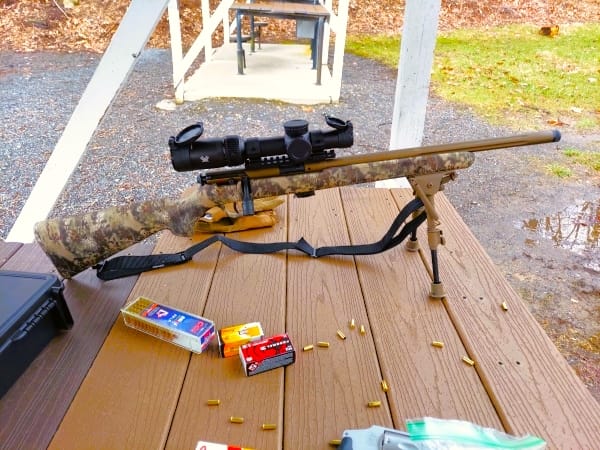
Without a doubt, the trigger contributed greatly to the Savage’s accuracy; it was a pure joy to use, with that nice, clean, crisp break. That heavy barrel is also a contributing factor to the accuracy. I can’t wait to stretch the rifle out to the 100-yard mark.
All in all, the Savage Mark II FV-SR is a major home run. It’s inexpensive, sturdy, accurate, cheap to feed, and just plain fun to shoot! At the time of writing, they retail for around $350 but can be found on gun shop shelves for less than that. Definitely check one out!


